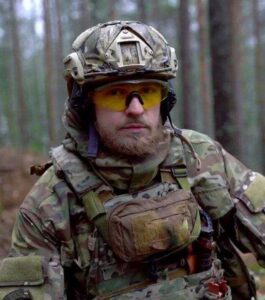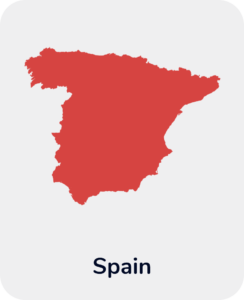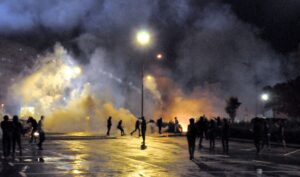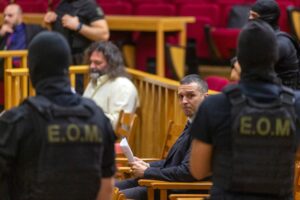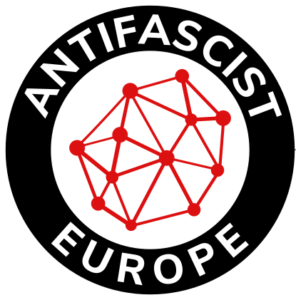Written by Alexander Tushkin. He is a Russian anti-fascist journalist and visiting researcher at the Berlin School of Economics and Law. Currently, he is a fellow of the Rosa Luxemburg Foundation’s International Research Group on Authoritarianism and Counter-Strategies.
How the Kremlin suppressed Russian nationalists, but ended up pursuing their greatest ambition
When Russia’s long-running conflict with Ukraine escalated into a full-blown invasion on 24 February 2022, Russian nationalists of all stripes rejoiced. For although Russian leader Vladimir Putin justified his so-called “special military operation” with talk of “denazification” and invoked the Soviet victory over Nazi Germany, the goals he is now pursuing in eastern Ukraine line up quite well with those of Russia’s most reactionary nationalists.
For years, Putin and other Kremlin ideologues have invoked the notion of the triune, or “All-Russian” nation, as political legitimation for Russia’s foreign policy vis-à-vis its post-Soviet neighbours. This concept, in many ways the foundational ideology of the Tsarist empire, claims that the “Russian people” consist of all inhabitants of historical Russia: Velikorosses (Great Russia), Malorosses (Little Russia), and Belorusses (White Russia), all of which are considered branches of one people. After the Bolsheviks overthrew the tsar in the October Revolution of 1917, they abandoned this concept in favour of a position that the three groups constituted separate nations. These ethnonyms were then replaced by Russians, Ukrainians, and Belarusians during the Soviet policy of korenizatsiya (indigenization) in the 1920s.
Whatever the shortcomings of Soviet ethnicities policy, it represented a step forward from the Great Russian chauvinism of the Tsarist past. Now, as Putin seeks ideological justification for his military aggression, he has returned the concept of a “triune Russian nation” to the political lexicon. His article “On the Historical Unity of Russians and Ukrainians”, published on the Kremlin’s website in July 2021, made the claim that “modern Ukraine is entirely the product of the Soviet era. We know and remember well that it was shaped — for a significant part — on the lands of historical Russia.”
Six months later, Putin invaded Ukraine. The nationalists cheered — the nationalists cried. For ironically, while claiming to battle the scourge of far-right extremists, the Russian Army is in some ways implementing their long-held irredentist agenda, while stirring up nationalism on both sides of the front. It represents the latest chapter in Putin’s long history of flirting with extremist ideologies to serve his own cynical political ends.
A House Divided
Russia’s war in Ukraine has had different impacts on nationalists in both camps. For Ukrainian nationalists, the war has heightened Ukrainian national consciousness, now sharpened by the shared suffering of war. Ukrainian nationalism is largely preoccupied with denying the existence of a common past with Russia and emphasizing a historically distinct Ukrainian nation. It is unlikely, however, that the nationalist project in Ukraine has made much progress beyond this opposition. As Ukrainian researcher Volodymyr Ishchenko writes, President Zelensky’s civic nationalism remains shallow: “Even now, it’s likely that Ukrainians are united in a typical ‘negative coalition’ against the invasion, not around any positive development project.”
Russian nationalism, on other hand, looks to an idealized past when both “brotherly peoples” — an expression commonly used by Russians — once lived happily under either the shadow of the Russian tsar or Soviet rule. Many Russian nationalists see the current war in Ukraine as a kind of revenge against the West, either for the collapse of the Russian Empire or the USSR. But unlike Ukrainians, Russian nationalists have not seen their unity increase during the war. On the contrary, the Ukrainian issue has caused a very deep rift, the first stage of which began back in 2014, so that nationalism in Russia now consists of a wide spectrum of far-right groupings gathered around two poles.
On one side are those who are conventionally called “imperialists”, who support the concept of a triune Russian nation and therefore a war with Ukraine. They often rally under the black–yellow–white flag of the Russian Empire. Typical representatives of the imperialists are the publicist Yegor Kholmogorov, or the Kremlin-aligned Orthodox oligarch Konstantin Malofeev who controls the Tsargrad media group.
Their attitude to the current Russian government varies: for example, Igor Girkin, also known as “Strelkov”, the leader of the Novorossiya movement and former Minister of Defence for the so-called Donetsk People’s Republic, is openly critical of Putin and the military leadership. Strelkov is no mere Russian nationalist and monarchist, but a military figure who prides himself on having sparked the cycle of war with Ukraine in 2014 by crossing the border with a squad of volunteers. Putin is also criticized by monarchists from the far-right Russian Imperial Movement, whose armed wing, the Imperial Legion, has been fighting in Ukraine for the last eight years. Also on Russia’s side is at least one outspoken neo-Nazi brigade, Alexey Milchakov’s prominent Rusich Group.
Some of the more notable nationalists who remain in Russia and have spoken out against the war include the former neo-Nazi skinhead Dmitry Demushkin, the Nation and Freedom Committee’s Vladimir Basmanov, and the tiny “Great Russia” party. For this oppositional minority of nationalists, the war is “fratricidal” (i.e., Slavs killing Slavs) and will only hasten the extinction of the Russians as a people, while the authorities repopulate the country with migrants from Central Asia and the Caucasus.
On the other side of the border are outspoken Russian neo-Nazis who fled to Ukraine back in 2014, where they joined Ukrainian nationalist volunteer units to fight against Putin’s “neo-Bolshevik horde”. In 2014, a Russian neo-Nazi wanted in his homeland for a series of murders, former National Socialist Society leader Sergey “Botsman” Korotkikh, joined the far-right Azov Battalion and personally received a Ukrainian passport from then-president Petro Poroshenko. Other neo-Nazis defected along with him, such as Alexey Levkin, leader of the neo-Nazi group Wotan Jugend and frontman of the National Socialist Black Metal (NSBM) band M8l8th, and neo-Nazi entrepreneur and MMA fighter Denis “WhiteRex” Kapustin.
Back in August, Kapustin organized the Russian Volunteer Corps (RDC), composed of Russian neo-Nazis in Ukraine. They display the chevrons of the Russian Liberation Army, Soviet collaborators who fought on the side of Nazi Germany in World War II. Now, the “white Aryans under the shadow of the swastika”, as Kapustin put it, are waging a new war on the side of Ukraine. In an interview with popular nationalist journalist Oleg Kashin in November, Kapustin explained: “I do not consider myself a traitor, a renegade or a defector. Russia is our beloved, our wonderful Motherland. But how does Russia feel about nationalists?”
Guided Nationalists in a Guided Democracy
Kapustin’s rhetorical question contains a kernel of truth. After all, the Kremlin’s policy towards Russian nationalism has been highly inconsistent and contradictory. On the one hand, nationalism is always potentially explosive in a large and multinational country like Russia. On the other, if kept in check, it can be a powerful political tool for the ruling elite.
In this sense, the career of Dimitry Rogozin, the former head of Roskosmos, the Russian space agency, and the most successful far-right politician in the Kremlin, is most revealing. He was recently named as the most likely candidate for the role of presidential representative to the occupied Ukrainian territories, meaning that a die-hard nationalist experienced in negotiations with NATO and modern weaponry will enforce Putin’s will on occupied land.
Rogozin is a product of a certain period in recent Russian history, namely the social and political chaos of the early 2000s, when Putin found it politically advantageous to permit the rise of the far right. The strategy became known as “guided nationalism”, a term derived from Russian political scientist Gleb Pavlovsky’s description of post-Soviet Russia as a “guided democracy” following Yeltsin’s assault on the State Duma in 1993. Guided democracy denotes a system in which democratic institutions are formally present, but actual public influence over the state is minimal. Guided nationalism, in turn, means that the state controls and directs nationalist sentiments in society to its own benefit.
Rogozin, then-leader of the nationalist Congress of Russian Communities, helped to establish the “Rodina” (Motherland) party in 2003 and became one of its two chairmen. He was elected to the State Duma shortly thereafter on the strength of a campaign designed to lure away voters from the Communist Party of the Russian Federation. That campaign made international headlines for its blatantly racist campaign video, described by the Guardian as such: “In the advert two party members approach a small group of swarthy men who are eating melon in a park. The rinds that the men discard foul the wheels of a pram pushed by a Slavic-looking Russian woman. The Rodina leader, Dmitry Rogozin, demands the men — who are played by actors — pick up their litter, but he receives no reply. His sidekick then claps a hand on the shoulder of one man and asks, ‘Do you understand Russian?’ Finally, a slogan appears on the screen saying: ‘Let’s clean our city of rubbish!’”
Four years later, the future deputy prime minister, face of Russia’s military-industrial complex, and head of the state agency in charge of the International Space Station would be on stage with neo-Nazis. To this day, Rodina’s presence in the Duma and Rogozin’s rise in the Kremlin represent the peak of guided nationalism’s success in Russia, unless one counts Vladimir Zhirinovsky’s right-populist Liberal Democratic Party, whose relationship the wider nationalist camp is strained.
The 2000s were a time of ideological experimentation, when a young Putin was trying to find his style. He was helped by his deputy chief of staff, Vladislav Surkov — still regarded as the Kremlin’s chief ideologue to this day. The views of this mysterious and sinister man, who shaped domestic policy in Russia for years, best reflect the Kremlin’s modus vivendi: cynical exploitation.
It was Surkov who helped create the ruling party, United Russia. It was Surkov who slipped Putin the books of the Russian fascist Ivan Ilyin. It was Surkov who shaped the ideology of the “Novorossiya” project, in which the imperialist ambitions of the Russian government found ideological expression. It was Surkov who coined the term Russki mir, “Russian world”, which became a codename for Russian imperialism.
Indeed, he admitted as much in his last public interview in 2021, after which he mysteriously disappeared. Rumours that he had been placed under house arrest emerged after the war began. Currently, he is said to have withdrawn from politics and is working on his memoirs, perhaps telling the story of how opportunistic flirtation with far-right thinking helped to prepare the ground for the tragedy in Ukraine.
Training Putin’s Youth
The first decade of Putin’s rule began with terror — a series of terrorist attacks swept through major Russian cities and the Second Chechen War broke out — and ended with terror, as far-right militants killed children, human rights activists, judges, and antifascists. While nationalism was first unleashed with the collapse of the USSR in the 1990s, since the early 2000s the authorities have actively played the nationalist card, thereby solving several problems at once: it helps to protect the regime against mass unrest by directing public frustration towards ethnic minorities, while at the same time exerting control over the far-right and focusing its ire on “foreigners”.
In the early 2000s, the Kremlin was on the hunt for an effective means of suppressing the so-called “colour revolutions” erupting across the post-Soviet space. The Rose Revolution in Georgia in 2003, the Orange Revolution in Ukraine one year later, and the Tulip Revolution in Kyrgyzstan in 2005 all followed the same playbook: crowds of dissatisfied people occupied central squares and refused to disperse, demanding that the government resign. Fearing a similar development back in Russia, Surkov decided to create government-controlled youth movements that could act against protesters if necessary.
The “Nashi” (Ours) movement, originally called the Youth Democratic Antifascist Movement “Ours!”, was founded in 2005. Experienced right-wing football hooligans from Spartak Moscow and CSKA Moscow served as the organization’s muscle, led by Roman “Spiky” Verbitsky. The leaders of fan groups Iva “Combat 18” Katanaev and Vasily “Vasya Killer” from Spartak and Alexey Mitryushin from CSKA, who became the personal security guard of the movement’s leader, also joined.
Katanaev, often described by the media as “Russia’s most famous football fan”, was an open fascist, once telling a hooligan magazine: “I was in one of the most radical skinhead hangouts. There was nothing more radical in Moscow. And if I take on something, I do it with full commitment. What’s my nickname? Combat. It comes from Combat 18, which is a terrorist organization in England. I was in the Russian branch, Blood & Honour Combat 18.” In another interview, he stressed that “I have no remorse for being a fascist. It’s like regretting being a communist.”
Nashi leaders actively cultivated this milieu for their movement. One leader, Vasili Yakemenko, was cited in the Financial Times in July 2005 as saying: “Skinheads are people just like you. So why provoke hostility? Moreover, skinheads sincerely believe that they are patriots of Russia. They should be offered an alternative. Why not invite 20 or 30 people here and show them that they have something to do?”
Formally organized as Nashi, right-wing football hooligans eagerly took care of the Kremlin’s dirty work: beating up activists and journalists, attacking the offices of opposition parties, and guarding important construction projects. In 2005, Roman Spiky and Vasya Killer vandalized the offices of Eduard Limonov’s National Bolshevik Party. In 2010, the same hooligans attacked environmentalists and antifascist activists who had blocked the construction of a toll highway through the Khimki Forest near Moscow. The far right’s involvement in the public conflict did not go unnoticed, and resulted in antifascists attacking the offices of Khimki municipality. Incidentally, this was the last antifascist mass action in Russia, after which the authorities launched a hunt for “left-wing radicals” and repressed the most active groups.
A Monster Is Born
No political movement can do without its own symbols and rituals, and the Kremlin set about drafting appropriate models for its new youth movement. Surkov suggested replacing the traditional Day of the Great October Socialist Revolution celebrations on 7 November with Unity Day on 4 November. That date soon became a major rallying point for the Russian far right. The first so-called “Russian March” took place in Moscow on that day in 2005, organized by the far-right philosopher Alexander Dugin’s Eurasian Youth Union and Alexander Potkin’s now-banned Movement against Illegal Immigration.
By the mid-2000s, ethno-nationalism was en vogue among young Russians. This was the era of the most famous Russian neo-Nazi skinhead and video blogger Maxim “Tesak” Martsinkevich, whose outrageous racist videos were watched by schoolchildren across Russia. Martsinkevich was jailed after being denounced by another nationalist blogger. Alexei Navalny, now considered Russia’s most important opposition figure, also began his career by filming outrageous racist videos, participating in the yearly “Russian March”, and flirting with far-right discourse.
The second half of the 2000s saw Russia’s far-right movement peak. Dozens of organizations, including radical neo-Nazi outfits, organized freely across the country, meeting no resistance from authorities. According to the SOVA Center, 50,000 neo-Nazis skinheads were active in Russia in the 2000s, although it is impossible to establish what proportion of them committed hate crimes. Their goal was to foment a National Socialist revolution, and their main method was street terror. While 152 murders committed by Nazis were registered in 2005, by 2009 the Investigative Committee of the Prosecutor’s Office calculated 548 such cases. In 2011, neo-Nazis from the National Socialist Society alone were found guilty of 27 murders and more than 50 assaults, as well as preparation for a terrorist attack on an electrical substation.
The Kremlin’s policy of guided nationalism turned out to be a Pandora’s Box, from which one of the bloodiest neo-Nazi battalions emerged: the Battle Organization of Russian Nationalists, or BORN. The group carried out nine assassinations between 2008 and 2011. Their victims included Moscow antifascists Fedor Filatov, Ilya Dzhaparidze, and Ivan Khutorskoy, federal judge Eduard Chuvashov, as well as lawyer Stanislav Markelov and journalist Anastasia Baburova.
BORN’s leaders later testified against each other and were sentenced to life in prison. Their testimony implied that they cooperated with presidential officials Nikita Ivanov, Pavel Karpov, and Leonid Simunin. They also confessed that they obtained the addresses of antifascists from police stations with the help of Nashi leader Alexei Mitryushin.
Although the BORN case was widely reported in the media and the links between authorities and the neo-Nazi underground were obvious, none of the officials in question were punished. Journalists later found Karpov and Simunin in Ukraine as members of the governments of the breakaway “People’s Republics” in Donetsk and Lugansk. Mitryushin for his part later became president of the CSKA rugby club.
Nationalism Is Dead, Long Live Nationalism!
The policy of guided nationalism began to crack apart in 2010, when several tens of thousands of football hooligans rioted at Moscow’s Manezhnaya Square on 11 December following the murder of Spartak fan Yegor Sviridov. The police’s behaviour during the murder investigation itself indicated to many that they were covering up for the suspects, and the rally soon escalated into clashes with the police. More than ten people were injured, dozens of protesters were detained, and several were prosecuted.
Vladimir Putin understood the threat emerging in his midst. When he laid flowers on Sviridov’s grave, he beseeched the hooligans: “Fan movements have always been distinguished by their independence from the authorities, independence from any political movement, and I want to make an urgent appeal to you not to allow anyone to put you under control and start manipulating you.”
This appeal would mark the epitaph on the tombstone of guided nationalism and the far-right movement in Russia as a whole. The Kremlin was frightened of the monster it had unleashed and decided to bury it. Guided democracy, by contrast, has proven to be resilient and effective in keeping society in check, and remains in place — albeit without its far-fight flank.
Between 2010 and 2015, security forces crushed the largest nationalist organizations. Blatant acquiescence and even encouragement from law enforcement agencies was replaced by stricter anti-extremist legislation, and the state began jailing citizens for posts on social media. The largest nationalist group, the Movement against Illegal Immigration, was banned in 2011 along with the organization founded to replace it, “Russkie”. Its leaders, Alexander Potkin and Dmitri Demushkin, went to prison. The racist blogger Martsinkevich went to prison for a third time, this time for life.
The Russian neo-Nazi scene broke apart and fled to Ukraine, after which the authorities decided to finally put an end to the far right in Russia. The leader of the International Eurasian Movement, Alexander Dugin, was banished from Moscow State University, where he was head of the Department of Sociology of International Relations. Although he returned to the headlines following the murder of his daughter in August 2022, Dugin’s influence has been restricted to small far-right circles for years.
During his first decade in power, Putin’s Kremlin used nationalism as a means of political consolidation. This found expression in electoral projects like Rogozin’s Rodina party, youth mobilizations, and far-right social movements like the Movement against Illegal Immigration. When the nationalists got out of control, they were dispensed with and the political space purged with mass repression. Today, the far-right movement in Russia is a shadow of its former self: a dozen tiny organizations, half of which work for the Kremlin in hopes of receiving state funds, while the other half spends its time putting up stickers with anti-immigrant and anti-vaccine slogans.
And yet, although the Russian state destroyed the nationalist movement, the war in Ukraine fulfilled its main dream: the trinity of the All-Russian people. The war gave new momentum to political processes and allowed the Kremlin to deploy ideological manipulation in the opposite direction. Russian ethno-nationalism was replaced by civic nationalism and antifascist symbolism inherited from the Soviet past, which became a cynical justification for the attack on Ukraine. This macabre transformation was best expressed by Dmitry Rogozin himself, who during Victory Day celebrations this year proclaimed: “Today it is extremely important for everyone to be active antifascists, because the threat of fascism persists.”
